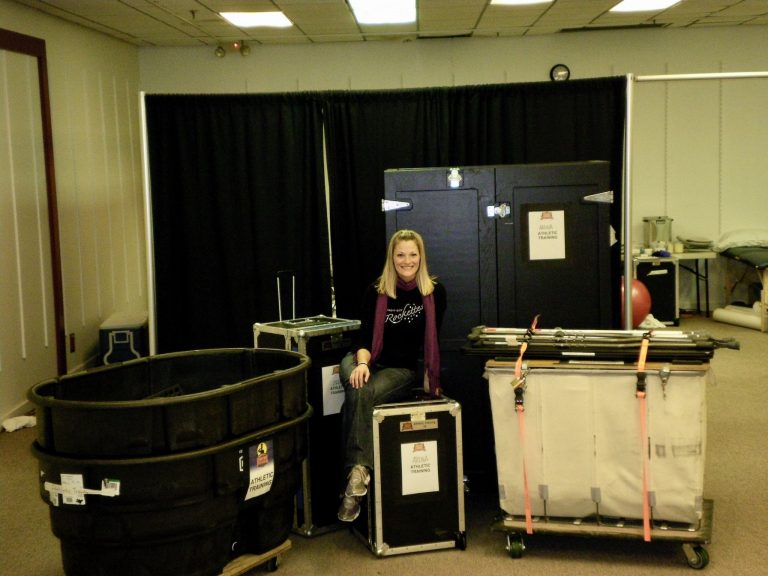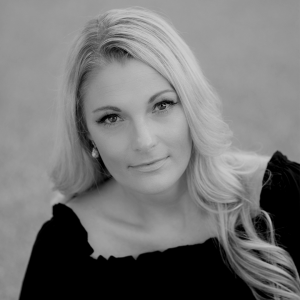
I spent a lot of my childhood behind the scenes. My aunt and uncle were working actors on Broadway, in the voice over studio, and performing in national and international tours. For a large part of my childhood years, I spent a lot of time in dressing rooms. I loved theatre, being in the theatre, and watching all of the behind the scenes and on stage action, but I never felt the call to the stage myself.
Let me re-phrase, I didn’t feel the call to the stage professionally. I loved performing in high school theatre and dabbled a bit in college, but I knew that I wanted to work backstage. At 17 years-old, my dream was to provide healthcare to performers. My path to the backstage was not easy. I had to create my own roadmap and decide that when I heard the word “no”, that I needed to find a way to turn it into a “yes”.
“Awe sweetie, that sounds so nice but no one is going to hire you.” These were the epic words that my loving Aunt Jodi Benson said to me at the tender age of 17 when I told her that I wanted to work with performers on shows. My first career “no” was coming from the Disney Legend and Tony Award nominee that had been gravely injured when a piece of scenery slammed into her face backstage during the original Broadway run of Crazy for You . She was also a seasoned actress that sought frequent massage, physical therapy and guidance from the medical profession in New York City to keep her body healthy and on-stage. Having a full-time athletic trainer or physical therapist employed on a show was simply unheard of in the entertainment industry in the 1980’s and 1990’s.
I heard “no” but I wanted to hear the word “yes”, so I began my journey.
When you think of The University of Alabama with their then 17 national championships in the NCAA Division I football, you don’t immediately associate them with performing arts medicine. You choose the University of Alabama because you love sports but I chose Alabama because it had the best accredited athletic training education program in the southeastern United States.
I’ll never forget the day when I told the Athletic Training Program Director that I wanted to pursue working in the performing arts. She too said “no” to my aspirations of working with dancers. My program director informed me that while I attended the University of Alabama I would work with men’s basketball, women’s tennis, soccer and the famous Crimson Tide football program and there were no opportunities in performing arts for me. Thus began my tenure with sports.
My first “yes” came the summer of my senior year when I was granted an internship at the University of North Carolina School of the Arts in Winston-Salem. I had scrubbed the interwebs to find an opportunity for a young college student to work with dancers and I had finally found it! This was no small feat in 2002 when social media has not been invented yet and Google was only four-years-old, certainly not the powerhouse search engine that it is now.
The internship was amazing but to be honest I felt quite sad when it ended. It was clear to me that the athletic trainer employed by the school was planning to stay at the job forever, and he did not need an assistant. So while the experience was epic, I was still not sure how to get a job in the performing arts after graduation in a field that was still so undiscovered.
Unbeknown to me, there were athletic trainers in the United States who were beginning to get gigs in the entertainment industry. Steve McCauley, ATC was working in Las Vegas on a sit down of Starlight Express, Elaine Winslow-Redmond, ATC was pulling double duty as a Radio City Rockette and athletic trainer at Radio City Musical Hall and Alan Kroll, ATC was freelancing with some shows in New York. There were only a few people working in the field in the United States in the early 2000’s and it was a small but mighty and determined group.
Graduation came and I had discovered three possible options to continue the road to my dream: pursue a Master of Kinesiology degree from Brigham Young University to work with ballroom dancers or Indiana University to work with ballet dancers or pause my dream and take a job working in sports.
I refused to give up on my dream and against huge odds, I was accepted as the graduate assistant for the Music School and Ballet program at Indiana University. It was a grueling year of studies, a massive financial drain, as American graduate schools can be, but I worked with ballet dancers every day. My dream was becoming a reality. I was working with performers! Upon graduation, I finally made the connections that I had been waiting for over so many years.
I met professional performing arts athletic trainers at the National Athletic Trainer’s Association annual convention in 2005 and for the very first time, I discovered that people like me had made it. They too believed that performers were athletes and deserved backstage care.
Let me set the finale for you. Fast forward two years and imagine me sitting across from my Aunt Jodi at a restaurant outside of Atlanta. My flip phone rings and I get the call. I am offered my very first national tour as the athletic trainer on Blast. It was an incredible full-circle moment to be sitting with my aunt who had basically told me that my dream was impossible because the industry did not exist, and now I was getting the offer for my first full-time job working with a production. Aunt Jodi began jumping up and down and making a huge scene with screams and tears in the restaurant. I was elated.
All of the “no’s” I received as I hit my head up against the preverbal wall finally paid off and I got my “yes”.
“Yes, I will take a chance on you”, “Yes, I will fight executive producers tooth and nail to get a full-time athletic trainer backstage”, and “yes, you can work with performers backstage and I will pay you for your work.”

To make it in the entertainment industry, you must have tenacity and bravery but most of all you have to work to turn a “no” into a “yes” with perseverance, hard work and drive. Hearing a “no” must ignite a fire in your heart and soul to transform the answer into a “yes”.
It is easy to give up when you hear a no or get a rejection in an area that involves your dreams but you must choose to fight harder when you meet resistance. If you choose to work in entertainment, you must be tough. In reality, it does not matter your chosen industry because in today’s competitive environment, people have to hustle to make it in their chosen professions.
I think everyone in the live entertainment and theatre industry can relate to getting a million “no’s” but the only thing that matters in the end is that first “yes”. That is the word that makes all of our blood, sweat, and tears worth it. At least until we hit our next “no” but we know that at some point we can turn it into a “yes”.
I had the incredible opportunity to work with some of the top grossing and most popular productions in the world during my performing arts medicine career. I provided injury prevention, treatment, education, and rehabilitation to performers with Cirque du Soleil when I worked as a staff athletic trainer with The Beatles Love, Viva Elvis and Mystere. I worked with Michael Flatley’s Lord of the Dance, Blue Man Group, The Lion King national tour, and the world-famous Radio City Rockettes on the Radio City Christmas Spectacular to name a few. Now the performing arts medicine industry is exploding and there are huge opportunities for students that want to pursue this profession. Producers and corporations know that they can decrease performer injuries if they hire an athletic trainer on their staff. Now, there are jobs out there for those that dream to work in this industry.
In 2012, I transitioned out of full time practice and moved into the business side of medicine and entertainment. I am proud of my journey in performing arts medicine and I love sharing my story with students. The advice that I always give is “never give up”. Persevering in the entertainment industry is tough but with hard work and determination, you can make anything happen. There is always a way to turn that “no” into a “yes”!
Are you interested in pursuing performing arts medicine? Here are resources for you:
National Athletic Trainer’s Association: Performing Arts Medicine
The Performing Arts Athletic Trainer’s Society
The University of Alabama Athletic Training Program
Operations Director In Paradise: Jamie Sullivans Journey to JOYÀ
Take A Deep Breath And Other Tips For Entry Level Creatives


Ashley Sutherland is Co-Founder of TheatreArtLife. Originally from Birmingham, Alabama in the United States of America, Ashley works in marketing and public relations specializing in the entertainment and healthcare fields. She is also a board certified and licensed Athletic Trainer. She holds a Bachelor of Science degree from The University of Alabama and a Master of Science degree from Indiana University. Ashley has worked as a performing arts medicine specialist and certified Athletic Trainer on some of the world's top-rated productions in the world. Some of her credits include "The Beatles LOVE", "Mystere", "Viva Elvis" and "Kooza" by Cirque du Soleil, Michael Flatley’s "Lord of the Dance", "Blue Man Group", "Blast!, the "Radio City Christmas Spectacular" with the legendary Radio City Rockettes, and the Indiana University Ballet. Ashley passionately advocates for pediatric cancer. She sits on the Board of Directors for Circus Couture, a charity, fashion, art, and performance event raising funds for research and treatment for cancer, genetic disorders, and hemophilia in children at The Children’s Specialty Center of Nevada and Cure 4 the Kids Foundation in Las Vegas, Nevada. Ashley resides in New York City.
Read Full Profile© 2021 TheatreArtLife. All rights reserved.

Thank you so much for reading, but you have now reached your free article limit for this month.
Our contributors are currently writing more articles for you to enjoy.
To keep reading, all you have to do is become a subscriber and then you can read unlimited articles anytime.
Your investment will help us continue to ignite connections across the globe in live entertainment and build this community for industry professionals.